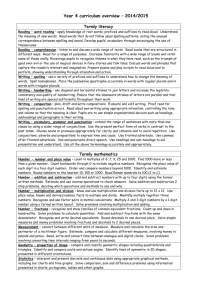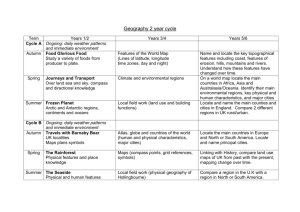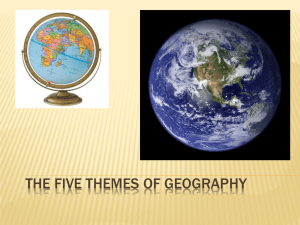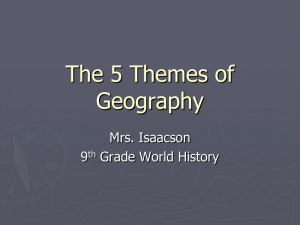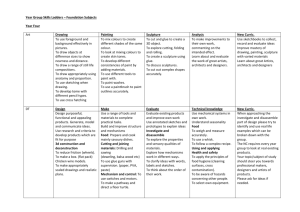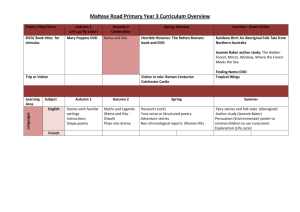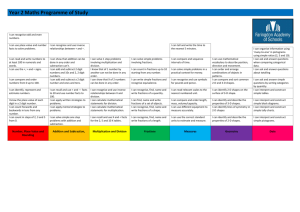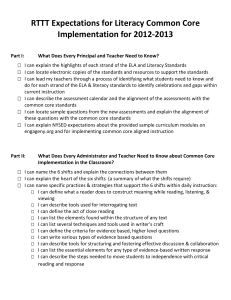To view the Year 3 termly overview click here
advertisement
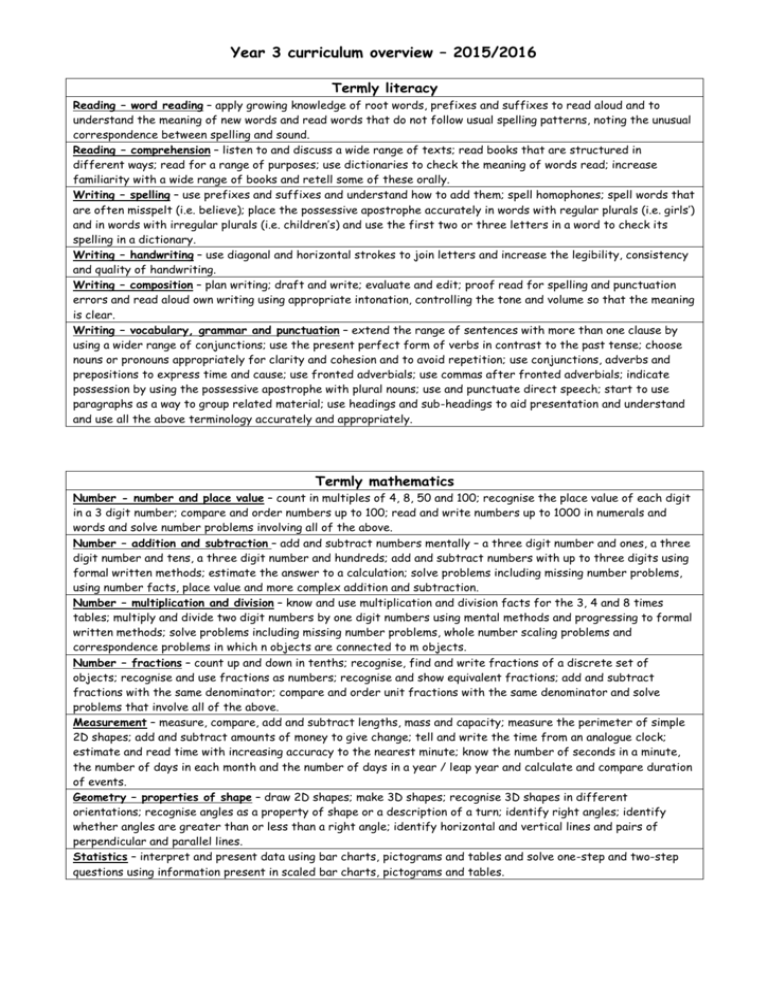
Year 3 curriculum overview – 2015/2016 Termly literacy Reading – word reading – apply growing knowledge of root words, prefixes and suffixes to read aloud and to understand the meaning of new words and read words that do not follow usual spelling patterns, noting the unusual correspondence between spelling and sound. Reading – comprehension – listen to and discuss a wide range of texts; read books that are structured in different ways; read for a range of purposes; use dictionaries to check the meaning of words read; increase familiarity with a wide range of books and retell some of these orally. Writing – spelling – use prefixes and suffixes and understand how to add them; spell homophones; spell words that are often misspelt (i.e. believe); place the possessive apostrophe accurately in words with regular plurals (i.e. girls’) and in words with irregular plurals (i.e. children’s) and use the first two or three letters in a word to check its spelling in a dictionary. Writing – handwriting – use diagonal and horizontal strokes to join letters and increase the legibility, consistency and quality of handwriting. Writing – composition – plan writing; draft and write; evaluate and edit; proof read for spelling and punctuation errors and read aloud own writing using appropriate intonation, controlling the tone and volume so that the meaning is clear. Writing – vocabulary, grammar and punctuation – extend the range of sentences with more than one clause by using a wider range of conjunctions; use the present perfect form of verbs in contrast to the past tense; choose nouns or pronouns appropriately for clarity and cohesion and to avoid repetition; use conjunctions, adverbs and prepositions to express time and cause; use fronted adverbials; use commas after fronted adverbials; indicate possession by using the possessive apostrophe with plural nouns; use and punctuate direct speech; start to use paragraphs as a way to group related material; use headings and sub-headings to aid presentation and understand and use all the above terminology accurately and appropriately. Termly mathematics Number - number and place value – count in multiples of 4, 8, 50 and 100; recognise the place value of each digit in a 3 digit number; compare and order numbers up to 100; read and write numbers up to 1000 in numerals and words and solve number problems involving all of the above. Number – addition and subtraction – add and subtract numbers mentally – a three digit number and ones, a three digit number and tens, a three digit number and hundreds; add and subtract numbers with up to three digits using formal written methods; estimate the answer to a calculation; solve problems including missing number problems, using number facts, place value and more complex addition and subtraction. Number – multiplication and division – know and use multiplication and division facts for the 3, 4 and 8 times tables; multiply and divide two digit numbers by one digit numbers using mental methods and progressing to formal written methods; solve problems including missing number problems, whole number scaling problems and correspondence problems in which n objects are connected to m objects. Number – fractions – count up and down in tenths; recognise, find and write fractions of a discrete set of objects; recognise and use fractions as numbers; recognise and show equivalent fractions; add and subtract fractions with the same denominator; compare and order unit fractions with the same denominator and solve problems that involve all of the above. Measurement – measure, compare, add and subtract lengths, mass and capacity; measure the perimeter of simple 2D shapes; add and subtract amounts of money to give change; tell and write the time from an analogue clock; estimate and read time with increasing accuracy to the nearest minute; know the number of seconds in a minute, the number of days in each month and the number of days in a year / leap year and calculate and compare duration of events. Geometry – properties of shape – draw 2D shapes; make 3D shapes; recognise 3D shapes in different orientations; recognise angles as a property of shape or a description of a turn; identify right angles; identify whether angles are greater than or less than a right angle; identify horizontal and vertical lines and pairs of perpendicular and parallel lines. Statistics – interpret and present data using bar charts, pictograms and tables and solve one-step and two-step questions using information present in scaled bar charts, pictograms and tables. Year 3 curriculum overview – 2015/2016 Autumn term Theme - Scavengers and Settlers Science: Rocks: compare and group together different kinds of rocks; describe in simple terms how fossils are formed. Geography: Use maps, atlases and globes; describe and understand key aspects of rivers; identify different types of settlements and why people choose to settle there. History: Timelines; finding out about the life skills of our earliest ancestors; finding out about changes in Britain from the Stone Age to the Iron Age. Art: Research and study cave paintings; make own pottery working on designing a pattern and creating it using tools. Eco-Schools: Global citizenship. Literacy links: Read and write stories with a historical setting and newspaper reports. Vocabulary: Scavenger, settler, hunter, gatherer, survival, Stone Age, Bronze Age, Iron Age, prehistoric, historians, fossils, fossilisation, artefacts, timeline, ancestors, remains, Otzi, settlements, population, village, chronology, cave painting, adapt, environment, tool making, life style, copper, gold, bronze, swords, armour. Theme – Wildlife Wizards - visit to Ecology Centre Science: Plants: identify and describe the function of different parts and explore what a plant needs to grow. Animals, including humans: identify the skeleton and muscles and understand that humans need the right type and amount of nutrition for a healthy life. Rocks: exploring different kinds of rocks and soils and recognising that soils are made from rocks and organic matter. Geography: Use fieldwork to observe and record the human and physical features in the local area. Art: Practise still life sketching of plants working on mark making skills and techniques to create shade and tone. Eco-Schools: Litter; biodiversity and school grounds. Literacy links: Read and write poetry and non-chronological reports. Vocabulary: habitats, nocturnal, wildlife, mammal, skeleton, muscles, exoskeleton, contract, relax, healthy, function, rock, soil, permeable, impermeable, food chain, herbivore, carnivore, producer, consume, endangered, trees, roots, branch, stem, trunk, stalk, leaf, flower, petal, seeds, bulbs, air, light, warmth, water, nutrients, life cycle, pollination, seed formation, seed dispersal, grow, growth, height, nutrition, balanced diet, healthy, unhealthy, food groups, vitamins, minerals, fats, proteins, carbohydrates, sugars, protect, support, muscles, rock, slate, chalk, limestone, granite, basalt, sandstone, flint, shale,marble, fossils, texture, absorbent, characteristic, surface. Theme – Turn it up! Science: Light: recognise that light is needed to see things and understanding shadows. Sound: understand how sound is made, identify pitch and volume. History: Research Thomas Edison, inventor of the light bulb. Art: Research a famous artist – Kadinsky. DT: Nuffield unit - What music would you like to make? Music: Organising sounds and using them expressively and creating simple pieces of music using notation. Eco-Schools: Energy saving. Literacy links: Read and write performance poetry and explanation texts. Vocabulary: sound, light, vibrate, vocal chords, sound waves, ear drum, pitch, Kadinsky, shadow, Thomas Edison, energy, dark, dull, bright, opaque, translucent, transparent, shadow, block, absence of light, reflect, bounce, mirror, reflection, light source, sun, sunset, sunrise, position, direction, night, day, volume, loud, quiet, pitch, low, high, source, soundproof, medium, ear, fainter. Discrete subjects Computing: We are programmers - programming an animation, We are bug fixers - finding and correcting bugs in programs. RE: Christianity. PSHE&C: New beginnings; Getting on & falling out and Saying no to bullying. PE: Dance; Tri-golf; Gym – create and perform fluent sequences on the floor and apparatus; Hockey. French: Greetings; name; age; numbers (1-12); brothers and sisters; colours; animals; days of the week and Christmas. Music: - Reggae and Big Band. Year 3 curriculum overview – 2015/2016 Spring term Theme – Active Planet Science: Rocks: identify layers of the Earth’s core and understand why a volcano erupts. Geography: Describe and understand the key features of volcanoes and earthquakes and use maps and atlases to locate them. History: Locate and research Pompeii. Art: Block printing - views of Mount Fuji by Hokusai. DT: Making a volcano model to demonstrate eruptions. Music: Listening to, composing and performing music with a repeating pattern. Literacy links: Read and write adventure stories and shape poems. Vocabulary: earthquake, volcano, erupt, lava, Pompeii, Vesuvius, richter scale, disaster, core, crust, mantle, layers, ring of fire, country, continent, active, dormant, molten rock, fossils, sedimentary, metamorphic, igneous, fossils, tectonic plates, current, melt, red hot magma, explode, volcanologists, hot ash, pumice, granite, weathering, sandstone, limestone, chalk, fault line. Theme – Caesar’s Reign – Roman workshop Geography: Using maps and atlases; identify trade links in the Roman era; research types of settlements and why people chose to settle there. History: Timelines; research the Roman Empire and its impact on Britain, Art: Create a Roman mosaic. DT: Nuffield unit – What displays will your class share? Literacy links: Read and write Roman myths and persuasive texts. Vocabulary: Caesar, reign, roman, Empire, invade, ancient, era, BC/AD, past, Europe, Rome, Romulus, Remus, ruler, Augustus, settlers, baths, gladiator, chariot, God/Goddess, spear, trade, toga, amphitheatre, barbarian, cavalry, chariot, cohort, forum, Londinium, mosaic, myth, slave, tax, villa. Theme – Wonka’s Wonders (continuing into Summer term) Science: Materials: explore a variety of everyday materials, develop simple descriptions of the states of matter and observe that materials change state when they are heated and cooled. Geography: Locate and name the continents on a world map; compare the UK with chocolate growing regions around the world. History: Research ancient civilisations. DT: Nuffield unit - How cool is your drink? Design and make a chocolate product. Eco-Schools: Fair trade; healthy living. Literacy links: Read and write stories from other cultures and instructions. Vocabulary: cocoa, chocolate, product, cocoa bean, Mayan, Central/South America, fair trade, Africa, tree, pod, bean, cacao trees, cacao farmers, scientists, bitter, dark, milk, taste, smell, ingredients, solid, liquid, states of matter, particles, heated, cooled, region. Discrete subjects Computing: We are presenters - videoing performances; We are network engineers - exploring computer networks. RE: Judaism. PSHE&C: Going for goals & safety; Good to be me; Healthy lifestyle. PE: Street dance; Basketball; Gym – travelling; Tennis. French: Alphabet; weather; parts of the body; shopping (café and shop); numbers (13-31); months of the year; fruit and veg and Easter. Music: - Basic instrumental skills, historical context of R&B and Reggae music. Year 3 curriculum overview – 2015/2016 Summer term Theme – Wonka’s Wonders (continuing from Spring term) Science: Materials: explore a variety of everyday materials, develop simple descriptions of the states of matter and observe that materials change state when they are heated and cooled. Geography: Locate and name the continents on a world map; compare the UK with chocolate growing regions around the world. History: Research ancient civilisations. DT: Nuffield unit - How cool is your drink? Design and make a chocolate product. Eco-Schools: Fair trade; healthy living. Literacy links: Read and write stories from other cultures and instructions. Vocabulary: cocoa, chocolate, product, cocoa bean, Mayan, Central/South America, fair trade, Africa, tree, pod, bean, cacao trees, cacao farmers, scientists, bitter, dark, milk, taste, smell, ingredients, solid, liquid, states of matter, particles, heated, cooled, region. Theme – Our World Science: Understand the water cycle. Understand how some materials can be separated. Plants: identify and describe the function of different parts and explore what a plant needs to grow. Animals, including humans: identify the skeleton and muscles and understand that humans need the right type and amount of nutrition for a healthy life. Geography: Identify the position and significance of the equator; the northern and southern hemispheres and the Tropics of Cancer and Capricorn. Locate and name continents on a world map; locate the main countries and capital cities in Europe; locate and name the countries and capital cities of the British Isles; identify rivers, deserts and mountains; compare a region of the UK with a region in Europe. Art: Study a variety of landscape paintings; create a landscape painting working on colour mixing. Music: Listen to music from different cultures and traditions; learn some songs from different cultures. Literacy links: Read and write stories with familiar settings and rhyming poems. Vocabulary: longitude, latitude, equator, continent, country, Tropic of Cancer, Tropic of Capricorn, Northern Hemisphere, Southern Hemisphere, cities, Asia, Africa, America, Oceania, Europe, British Isles, rivers, deserts, mountains, region, United Kingdom, water cycle, evaporation, condensation, soluble, non-soluble, root, stem, petal, leaf, stamen, pollen, stigma, pollination, bud, anther, filament, style, ovary, skeleton, ribs, cranium, radius, femur, spine, nutrition, healthy Theme – Dig for Victory - visit to Imperial War Museum Geography: Locate the main countries of Europe; locate and name the countries and capital cities of Europe. History: Timelines; learn and understand the key dates and events of WWII; investigate the social history of WWII including fashion, rationing and the evacuation of children. Art: Design a blitz picture. Music: Listen to music from WWII era. Eco-Schools: Healthy living; Dig for Victory; Reusing waste. Literacy links: Read and write play scripts, letters and diaries. Vocabulary: timeline, dates, outbreak, Germany, allies, invade, enemies, neutral, Switzerland, Poland, France, Italy, Russia, Nazi, Swastika, evacuees, rationing, propaganda, air raid siren, Blitz, bunkers, shelters, gas mask, bombs, destruction, Doodlebug, spitfire, Bismarck, Adolf Hitler, Winston Churchill, telegram, VE day. Discrete subjects Computing: We are communicators - communicating safely on the internet, We are opinion pollsters - collecting and analysing data. RE: Hinduism. PSHE&C: Changes and safety; Relationships and drugs. PE: Athletics; Gym – jumping, landing and shape; Swimming. French: Food; family; hobbies; weather; where we live; my bedroom and my house. Music: Musical styles – Soul, Motown and Western Classical.
